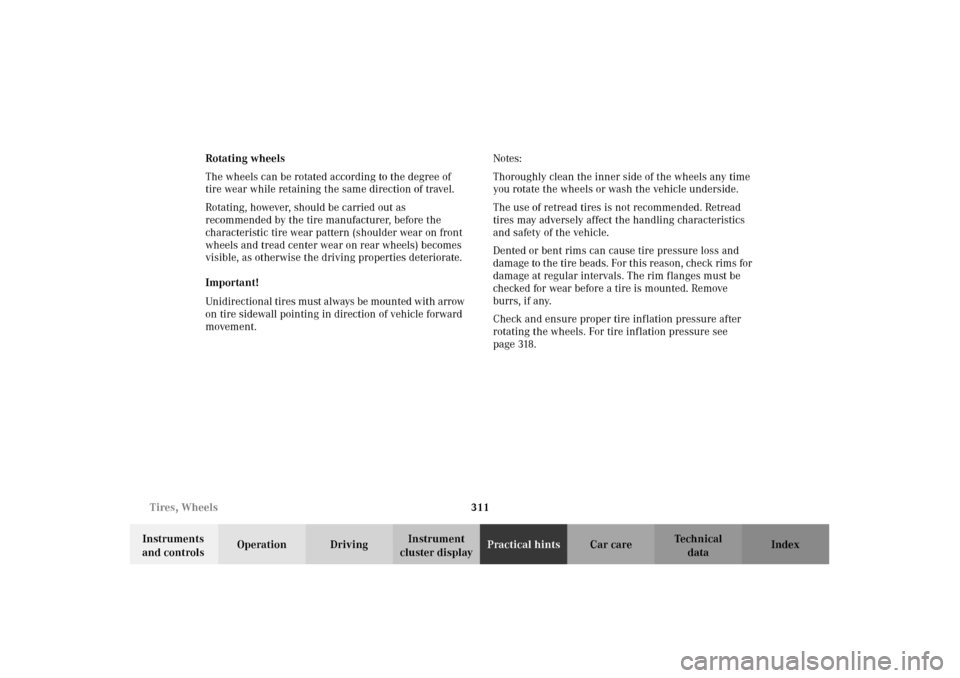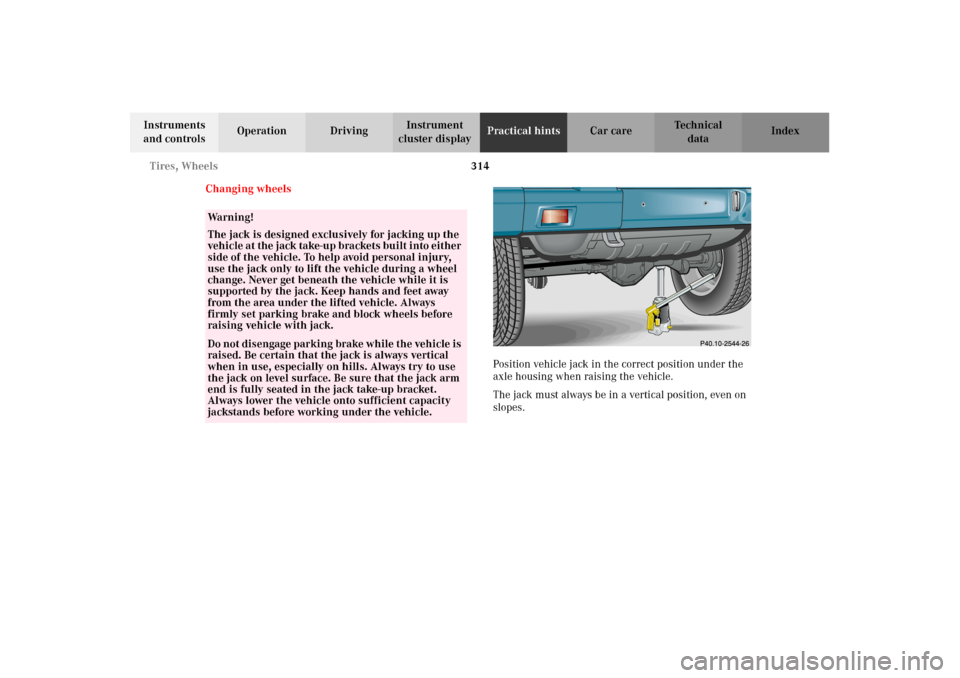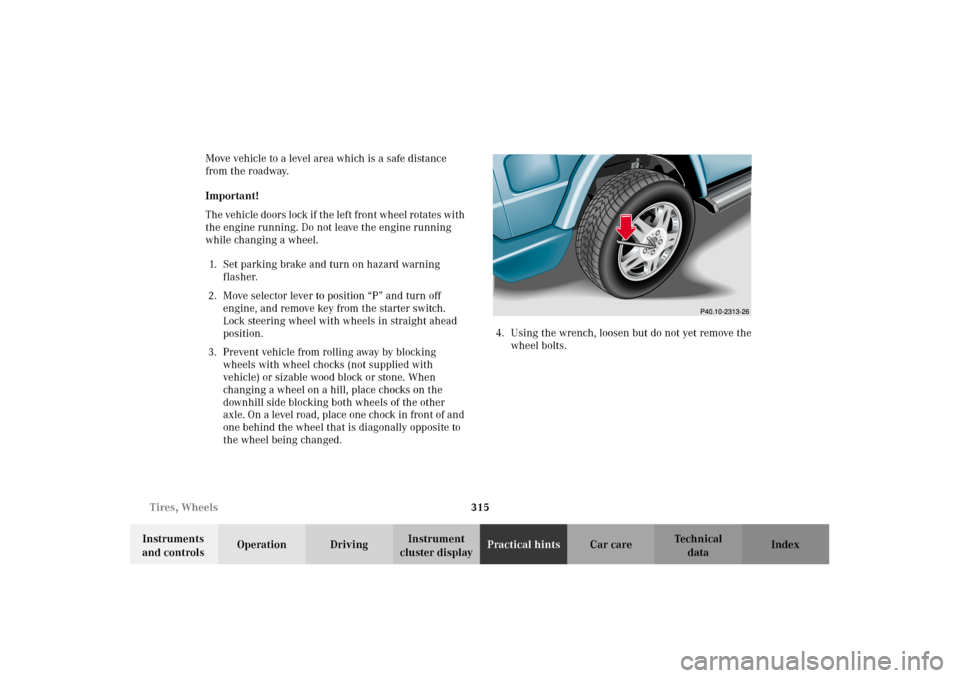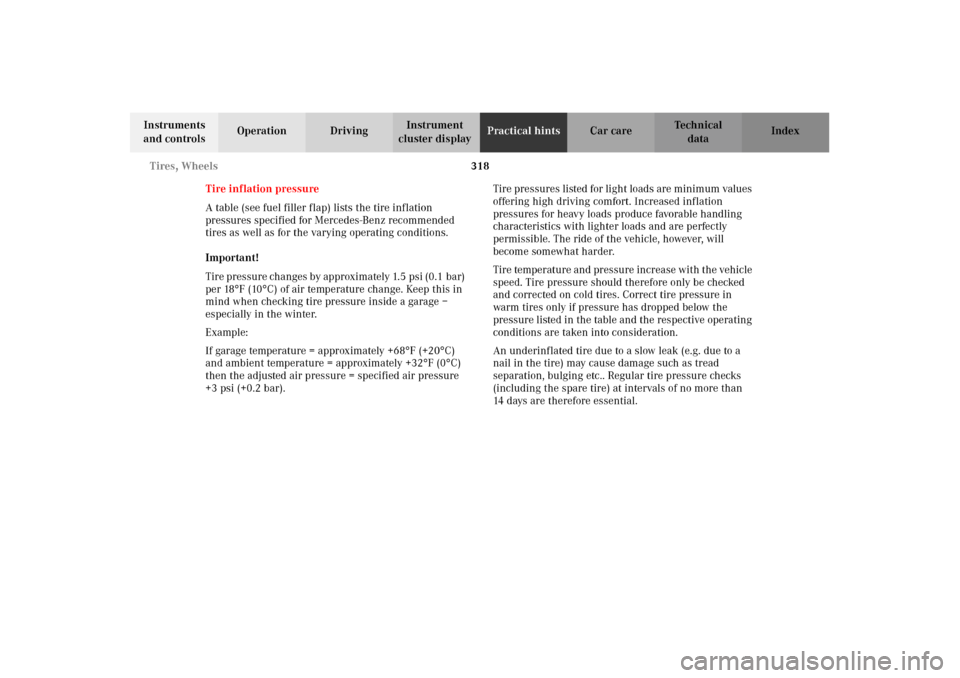Page 314 of 385

311 Tires, Wheels
Te ch n i c a l
data Instruments
and controlsOperation DrivingInstrument
cluster displayPractical hintsCar care Index Rotating wheels
The wheels can be rotated according to the degree of
tire wear while retaining the same direction of travel.
Rotating, however, should be carried out as
recommended by the tire manufacturer, before the
characteristic tire wear pattern (shoulder wear on front
wheels and tread center wear on rear wheels) becomes
visible, as otherwise the driving properties deteriorate.
Important!
Unidirectional tires must always be mounted with arrow
on tire sidewall pointing in direction of vehicle forward
movement.Notes:
Thoroughly clean the inner side of the wheels any time
you rotate the wheels or wash the vehicle underside.
The use of retread tires is not recommended. Retread
tires may adversely affect the handling characteristics
and safety of the vehicle.
Dented or bent rims can cause tire pressure loss and
damage to the tire beads. For this reason, check rims for
damage at regular intervals. The rim flanges must be
checked for wear before a tire is mounted. Remove
burrs, if any.
Check and ensure proper tire inflation pressure after
rotating the wheels. For tire inflation pressure see
page 318.
J_G463.book Seite 311 Mittwoch, 19. September 2001 8:06 08
Page 315 of 385
312 Tires, Wheels
Te ch n i c a l
data Instruments
and controlsOperation DrivingInstrument
cluster displayPractical hintsCar care Index
Spare wheel cover
To remove spare wheel cover:
Open lock (1) with the key for spare wheel cover.
Pull the cover ring (2) slightly outwards in direction of
arrows and remove.
Remove cover plate (3).To reinstall spare wheel cover:
Ensure that catch (4) engages in recess (5) when
pushing cover plate (3) on.
Keep care when mounting cover ring (2), that the
lock (1) faces downwards.
Note:
Always keep the key in a safe and easily accessible
place in the vehicle.
3
2
1
J_G463.book Seite 312 Mittwoch, 19. September 2001 8:06 08
Page 316 of 385
313 Tires, Wheels
Te ch n i c a l
data Instruments
and controlsOperation DrivingInstrument
cluster displayPractical hintsCar care Index Spare wheel
Important!
The spare wheel rim is mounted with a full size tire of
the same type as on the vehicle, and is fully functional.
In the case of a flat tire, you may use the spare wheel.
For rim and tire specifications, refer to “Technical data”
on page 359.
Note:
Repair or replace damaged tire at your earliest
convenience.
To gain access to spare wheel, remove spare wheel
cover, see page 312.
Remove nuts (1) and take spare wheel off the spare
wheel carrier.
Place the punctured wheel on the spare wheel carrier,
secure it with the nuts (1) and cover it with the spare
wheel cover.
Note:
For safety reasons check regularly that the spare wheel
is securely fastened.
P40.10-2312-26
1
1
1
J_G463.book Seite 313 Mittwoch, 19. September 2001 8:06 08
Page 317 of 385

314 Tires, Wheels
Te ch n i c a l
data Instruments
and controlsOperation DrivingInstrument
cluster displayPractical hintsCar care Index
Changing wheels
Position vehicle jack in the correct position under the
axle housing when raising the vehicle.
The jack must always be in a vertical position, even on
slopes.
Wa r n i n g !
The jack is designed exclusively for jacking up the
vehi c le a t the j ack take-up b ra ckets b ui lt i nto eit her
side of the vehicle. To help avoid personal injury,
use the jack only to lift the vehicle during a wheel
change. Never get beneath the vehicle while it is
supported by the jack. Keep hands and feet away
from the area under the lifted vehicle. Always
firmly set parking brake and block wheels before
raising vehicle with jack.Do n ot d is engage parki n g brake w hil e t he vehi c le i s
raised. Be certain that the jack is always vertical
when in use, especially on hills. Always try to use
the jack on level surface. Be sure that the jack arm
end is fully seated in the jack take-up bracket.
Always lower the vehicle onto sufficient capacity
jackstands before working under the vehicle.
J_G463.book Seite 314 Mittwoch, 19. September 2001 8:06 08
Page 318 of 385

315 Tires, Wheels
Te ch n i c a l
data Instruments
and controlsOperation DrivingInstrument
cluster displayPractical hintsCar care Index Move vehicle to a level area which is a safe distance
from the roadway.
Important!
The vehic le door s lock if t he lef t f ron t wheel r otate s with
the engine running. Do not leave the engine running
while changing a wheel.
1. Set parking brake and turn on hazard warning
flasher.
2. Move selector lever to position “P” and turn off
engine, and remove key from the starter switch.
Lock steering wheel with wheels in straight ahead
position.
3. Prevent vehicle from rolling away by blocking
wheels with wheel chocks (not supplied with
vehicle) or sizable wood block or stone. When
changing a wheel on a hill, place chocks on the
downhill side blocking both wheels of the other
axle. On a level road, place one chock in front of and
one behind the wheel that is diagonally opposite to
the wheel being changed.4. Using the wrench, loosen but do not yet remove the
wheel bolts.
J_G463.book Seite 315 Mittwoch, 19. September 2001 8:06 08
Page 319 of 385
316 Tires, Wheels
Te ch n i c a l
data Instruments
and controlsOperation DrivingInstrument
cluster displayPractical hintsCar care Index
5. The jack must always be in a vertical position, even
on slopes. Place jack under axle housing. Be certain
the jack arm is positioned correctly under the axle
housing.
6. Jack up the vehicle until the wheel is clear of the
ground. Never start engine while vehicle is raised.7. Now finish to unscrew and remove all wheel bolts.
Keep bolt threads protected from dirt and sand.
8. Remove wheel. Grip wheel from the sides. Keep
hands from beneath the wheels.
Clean contact surfaces of wheel and wheel hub.
Install spare wheel on wheel hub. Insert wheel bolts
and tighten them slightly.
9. Lower vehicle to ground. Remove jack.
Before storing the jack, it should be fully collapsed.
For proper storage of jack see page 296.
J_G463.book Seite 316 Mittwoch, 19. September 2001 8:06 08
Page 320 of 385
317 Tires, Wheels
Te ch n i c a l
data Instruments
and controlsOperation DrivingInstrument
cluster displayPractical hintsCar care Index With the vehicle lowered to ground, tighten the five
bolts evenly using the wrench. When tigthening follow
the sequence illustrated, until all bolts are tight.
Observe a tightening torque of 97 ft.lb. (130 Nm).
Ensure proper tire pressure, see page 318.
Wa r n i n g !
Always replace wheel bolts that are damaged or
rusted.Never apply oil or grease to wheel bolts.Damaged wheel hub threads should be repaired
immediately.Incorrect mounting bolts or improperly tightened
mounting bolts can cause the wheel to come off.
This could cause an accident. Be sure to use the
correct mounting bolts.
J_G463.book Seite 317 Mittwoch, 19. September 2001 8:06 08
Page 321 of 385

318 Tires, Wheels
Te ch n i c a l
data Instruments
and controlsOperation DrivingInstrument
cluster displayPractical hintsCar care Index
Tire inflation pressure
A table (see fuel filler flap) lists the tire inflation
pressures specified for Mercedes-Benz recommended
tires as well as for the varying operating conditions.
Important!
Tire pressure changes by approximately 1.5 psi (0.1 bar)
per 18
°F (10
°C) of air temperature change. Keep this in
mind when checking tire pressure inside a garage –
especially in the winter.
Example:
If garage temperature = approximately +68
°F (+20
°C)
and ambient temperature = approximately +32
°F (0
°C)
then the adjusted air pressure = specified air pressure
+3 psi (+0.2 bar).Tire pressures listed for light loads are minimum values
offering high driving comfort. Increased inflation
pressures for heavy loads produce favorable handling
characteristics with lighter loads and are perfectly
permissible. The ride of the vehicle, however, will
become somewhat harder.
Tire temperature and pressure increase with the vehicle
speed. Tire pressure should therefore only be checked
and corrected on cold tires. Correct tire pressure in
warm tires only if pressure has dropped below the
pressure listed in the table and the respective operating
conditions are taken into consideration.
An underinflated tire due to a slow leak (e.g. due to a
nail in the tire) may cause damage such as tread
separation, bulging etc.. Regular tire pressure checks
(including the spare tire) at intervals of no more than
14 days are therefore essential.
J_G463.book Seite 318 Mittwoch, 19. September 2001 8:06 08